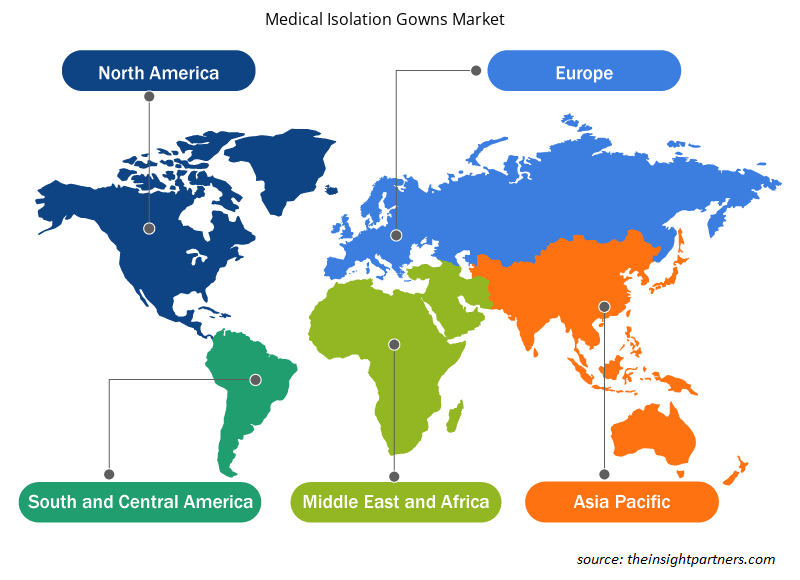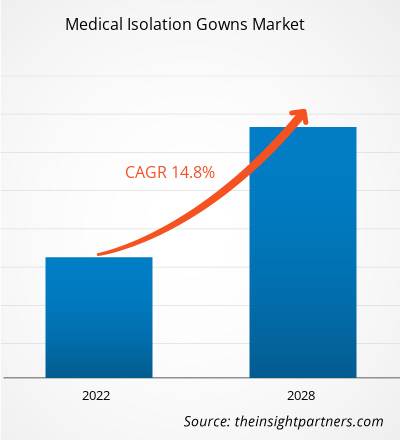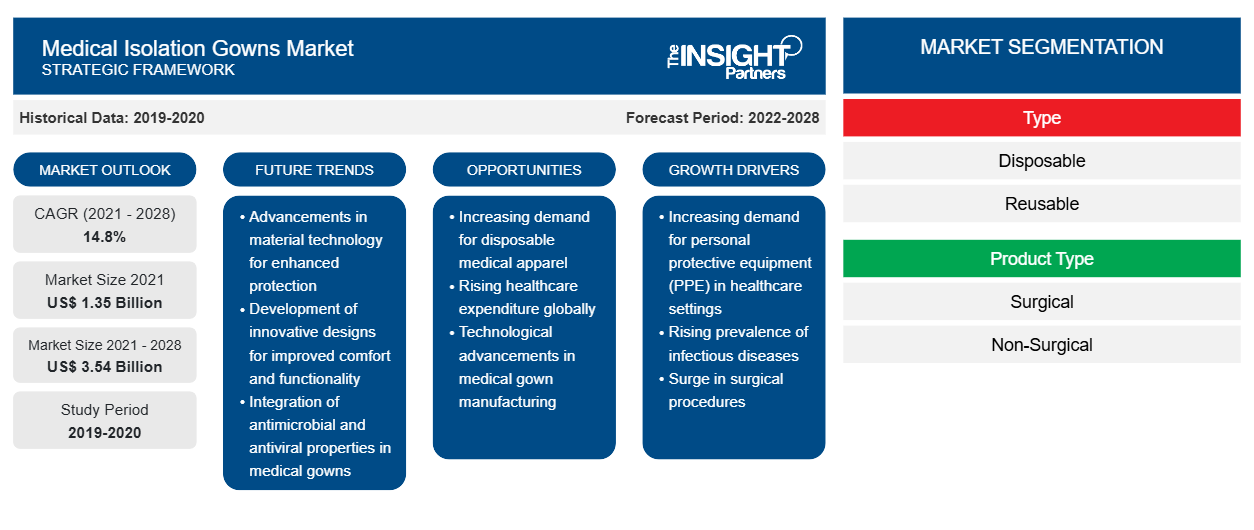Der Markt für medizinische Isolationskittel soll von 1.346,31 Millionen US-Dollar im Jahr 2021 auf 3.542,78 Millionen US-Dollar im Jahr 2028 anwachsen; von 2021 bis 2028 wird mit einer durchschnittlichen jährlichen Wachstumsrate von 14,8 % gerechnet.
Der Bericht bietet Einblicke und eine eingehende Analyse des Marktes für medizinische Isolationskittel und legt dabei den Schwerpunkt auf verschiedene Parameter wie Markttrends und -chancen, Marktdynamik und Wettbewerbslandschaftsanalyse führender Marktteilnehmer in Nordamerika, Europa, im asiatisch-pazifischen Raum, in Süd- und Mittelamerika sowie im Nahen Osten und Afrika. Er enthält auch die Auswirkungsanalyse der COVID-19-Pandemie auf die Regionen.
Passen Sie diesen Bericht Ihren Anforderungen an
Sie erhalten kostenlos individuelle Anpassungen an jedem Bericht, einschließlich Teilen dieses Berichts oder einer Analyse auf Länderebene, eines Excel-Datenpakets sowie tolle Angebote und Rabatte für Start-ups und Universitäten.
- Holen Sie sich die wichtigsten Markttrends aus diesem Bericht.Dieses KOSTENLOSE Beispiel umfasst eine Datenanalyse von Markttrends bis hin zu Schätzungen und Prognosen.
Markteinblicke
Sensibilisierung für im Krankenhaus erworbene Infektionen
Patienten ziehen sich im Krankenhaus oder in einer anderen Gesundheitseinrichtung Krankenhausinfektionen oder im Rahmen der medizinischen Versorgung erworbene nosokomial erworbene Infektionen (HAI) zu. Diese Infektionen werden durch gängige Krankheitserreger wie Bakterien, Viren, Pilze und Parasiten verursacht. Zu den HAI zählen katheterbedingte Harnwegsinfektionen, Wundinfektionen (SSI), zentralvenöse Venenkatheter-assoziierte Blutbahninfektionen, beatmungsassoziierte Pneumonie, im Krankenhaus erworbene Pneumonie und verschiedene andere Infektionen. Auch viele chirurgische Geräte können HAI-Verbreiter sein.
HAIs weisen eine hohe Morbiditäts- und Mortalitätsrate auf und kosten das Gesundheitssystem jedes Jahr Milliarden von Dollar. Die Centers for Disease Control (CDC) berichteten, dass HAIs jedes Jahr für etwa 1,7 Millionen Infektionsfälle und 99.000 Todesfälle in amerikanischen Krankenhäusern verantwortlich sind. Bei allen medizinischen Eingriffen in Gesundheitseinrichtungen ist das Tragen von Isolationskitteln vorgeschrieben. Sie helfen, Kreuzkontaminationen, die Übertragung von Körperflüssigkeiten und infektionserregenden Mikroorganismen sowie das Eindringen von Flüssigkeiten zu verhindern. Regierungsbehörden wie das National Healthcare Safety Network (NHSN) des Center for Disease Control and Prevention (CDC) überwachen die Infektionen genau, um HAI zu verhindern und die Patientensicherheit zu erhöhen. In den USA arbeitet das Department of Health and Human Services (HHS) daran, HAI-Fälle zu reduzieren. Darüber hinaus überwacht in Europa das Healthcare-Associated Infections Surveillance Network (HAI-Net) diese Infektionen in der Region, und die Funktion des HAI-NET wird vom Europäischen Zentrum für die Prävention und Kontrolle von Krankheiten (ECDC) verwaltet und kontrolliert. Eine Umfrage mit dem Titel „Bewusstsein für HAIs unter Medizinstudenten in einem Zentrum der tertiären Versorgung“ ergab beispielsweise, dass insgesamt 82 % (von 250) der Studenten über HAIs informiert waren.
Typbasierte Erkenntnisse
Der Markt für medizinische Isolationskittel ist je nach Typ in Einweg- und Mehrwegkittel unterteilt. Das Einwegsegment hatte 2021 einen größeren Marktanteil. Es wird jedoch geschätzt, dass das Mehrwegsegment im Prognosezeitraum eine höhere durchschnittliche jährliche Wachstumsrate (CAGR) von 15,5 % auf dem Markt verzeichnen wird.
Produkttypbasierte Einblicke
Basierend auf dem Produkttyp ist der Markt für medizinische Isolationskittel in chirurgische und nicht-chirurgische unterteilt. Das chirurgische Segment hielt im Jahr 2021 einen größeren Marktanteil. Es wird jedoch geschätzt, dass das nicht-chirurgische Segment im Prognosezeitraum eine höhere durchschnittliche jährliche Wachstumsrate (CAGR) von 15,1 % verzeichnet.
Anorganische Strategien wie Fusionen und Übernahmen werden häufig von Unternehmen eingesetzt, um den sich ändernden Kundenanforderungen gerecht zu werden und ihre Markennamen weltweit zu behaupten. Akteure auf dem Markt für medizinische Isolationskittel setzen auch organische Strategien wie Produkteinführung und -erweiterung ein, um ihre Präsenz und ihr Produktportfolio weltweit auszuweiten und die wachsende Nachfrage zu befriedigen.
Regionale Einblicke in den Markt für medizinische Isolationskittel
Die regionalen Trends und Faktoren, die den Markt für medizinische Isolationskittel während des Prognosezeitraums beeinflussen, wurden von den Analysten von Insight Partners ausführlich erläutert. In diesem Abschnitt werden auch die Marktsegmente und die Geografie für medizinische Isolationskittel in Nordamerika, Europa, im asiatisch-pazifischen Raum, im Nahen Osten und Afrika sowie in Süd- und Mittelamerika erörtert.

- Erhalten Sie regionale Daten zum Markt für medizinische Isolationskittel
Umfang des Marktberichts zu medizinischen Isolationskitteln
| Berichtsattribut | Details |
|---|---|
| Marktgröße im Jahr 2021 | 1,35 Milliarden US-Dollar |
| Marktgröße bis 2028 | 3,54 Milliarden US-Dollar |
| Globale CAGR (2021 - 2028) | 14,8 % |
| Historische Daten | 2019-2020 |
| Prognosezeitraum | 2022–2028 |
| Abgedeckte Segmente | Nach Typ
|
| Abgedeckte Regionen und Länder | Nordamerika
|
| Marktführer und wichtige Unternehmensprofile |
|
Dichte der Marktteilnehmer für medizinische Isolationskittel: Die Auswirkungen auf die Geschäftsdynamik verstehen
Der Markt für medizinische Isolationskittel wächst rasant, angetrieben durch die steigende Nachfrage der Endnutzer aufgrund von Faktoren wie sich entwickelnden Verbraucherpräferenzen, technologischen Fortschritten und einem größeren Bewusstsein für die Vorteile des Produkts. Mit steigender Nachfrage erweitern Unternehmen ihr Angebot, entwickeln Innovationen, um die Bedürfnisse der Verbraucher zu erfüllen, und nutzen neue Trends, was das Marktwachstum weiter ankurbelt.
Die Marktteilnehmerdichte bezieht sich auf die Verteilung der Firmen oder Unternehmen, die in einem bestimmten Markt oder einer bestimmten Branche tätig sind. Sie gibt an, wie viele Wettbewerber (Marktteilnehmer) in einem bestimmten Marktraum im Verhältnis zu seiner Größe oder seinem gesamten Marktwert präsent sind.
Die wichtigsten auf dem Markt für medizinische Isolationskittel tätigen Unternehmen sind:
- Cardinal Health, Inc.
- Medline Industries, Inc.
- Leboo Healthcare Produkte GmbH
- Narang Medical GmbH
- Shanghai Medical Corporation
Haftungsausschluss : Die oben aufgeführten Unternehmen sind nicht in einer bestimmten Reihenfolge aufgeführt.

- Überblick über die wichtigsten Akteure auf dem Markt für medizinische Isolationskittel
Nach Typ
- Einweg
- Wiederverwendbar
Nach Produkttyp
- Chirurgisch
- Nicht-chirurgisch
Nach Endbenutzer
- Krankenhäuser
- Ambulante Chirurgische Zentren
- Kliniken
- Sonstiges
Nach Geografie
- Nordamerika
- UNS
- Kanada
- Mexiko
- Europa
- Serbien
- Vereinigtes Königreich
- Russland
- Polen
- Estland
- Litauen
- Schweden
- Slowakei
- Finnland
- Deutschland
- Frankreich
- Italien
- Spanien
- Restliches Europa
- Asien-Pazifik
- China
- Japan
- Indien
- Australien
- Südkorea
- Restlicher Asien-Pazifik-Raum
- Naher Osten und Afrika
- Vereinigte Arabische Emirate
- Saudi-Arabien
- Afrika
- Restlicher Naher Osten und Afrika
- Süd- und Mittelamerika
- Brasilien
- Argentinien
- Restliches Süd- und Mittelamerika
Firmenprofile
- Cardinal Health, Inc.
- Medline Industries, LP
- Leboo Healthcare Produkte GmbH
- Narang Medical GmbH
- Shanghai Medical Corporation
- Mölnlycke Health Care AB
- Advin Gesundheitspflege
- Dispotech S.r.l.
- Standard Textile Co., Inc.
- PRIONTEX
- Sara Healthcare Pvt. Ltd.
- Historische Analyse (2 Jahre), Basisjahr, Prognose (7 Jahre) mit CAGR
- PEST- und SWOT-Analyse
- Marktgröße Wert/Volumen – Global, Regional, Land
- Branchen- und Wettbewerbslandschaft
- Excel-Datensatz
Aktuelle Berichte
Verwandte Berichte
Erfahrungsberichte
Grund zum Kauf
- Fundierte Entscheidungsfindung
- Marktdynamik verstehen
- Wettbewerbsanalyse
- Kundeneinblicke
- Marktprognosen
- Risikominimierung
- Strategische Planung
- Investitionsbegründung
- Identifizierung neuer Märkte
- Verbesserung von Marketingstrategien
- Steigerung der Betriebseffizienz
- Anpassung an regulatorische Trends























 Kostenlose Probe anfordern für - Markt für medizinische Isolationskittel
Kostenlose Probe anfordern für - Markt für medizinische Isolationskittel